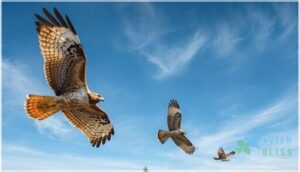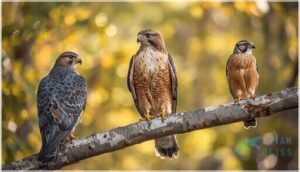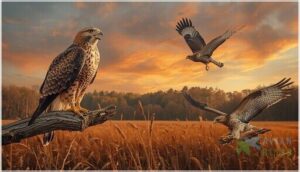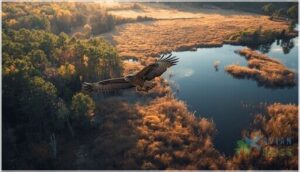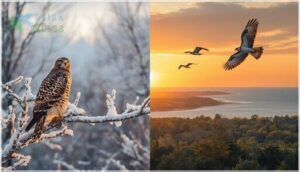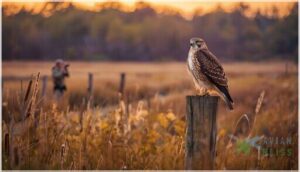This site is supported by our readers. We may earn a commission, at no cost to you, if you purchase through links.
A Red-tailed Hawk lifts off from a weathered fence post along I-75, its brick-red tail catching the afternoon light as it circles over an open field. This scene plays out thousands of times across Michigan every day, yet most drivers never glance up.
Eight distinct hawk species call Michigan home at different times of the year, from the tiny Sharp-shinned Hawk that hunts songbirds in your backyard to the impressive Northern Goshawk prowling deep northern forests. Learning to identify these raptors transforms ordinary outdoor moments into wildlife encounters, whether you’re hiking state parks, watching birds from your deck, or simply scanning telephone wires during your commute.
Each species brings its own hunting style, habitat preferences, and seasonal patterns to Michigan’s diverse landscapes.
Table Of Contents
- Key Takeaways
- Common Hawk Species in Michigan
- Hawk Identification Guide for Michigan
- Habitat and Distribution Across Michigan
- Migration and Seasonal Patterns
- Conservation and Birdwatching Opportunities
- Frequently Asked Questions (FAQs)
- In Michigan, what kind of hawk do you see most often?
- In what ways can I tell whether I’m looking at a hawk?
- Is it good to have a hawk in your yard?
- What does it mean when a hawk hangs around your yard?
- How do you identify a hawk?
- What to do if a hawk is in your yard?
- What type of hawk is in Michigan?
- What is the most common bird of prey in Michigan?
- Why would a hawk be in my yard?
- Why are hawks around my house?
- Conclusion
Key Takeaways
- Michigan is home to eight distinct hawk species, each with unique hunting styles, feather patterns, and habitat preferences.
- Red-tailed Hawks are the most commonly seen raptors in Michigan, thriving year-round in urban, rural, and open country landscapes.
- Seasonal migrations bring Broad-winged and Rough-legged Hawks to the state, with peak viewing along Great Lakes shorelines and wetland corridors.
- Conservation efforts protect over 15,000 square miles of hawk habitat, while citizen science and backyard habitat improvements support healthy raptor populations.
Common Hawk Species in Michigan
Michigan’s skies and forests host eight outstanding hawk species, each with unique traits that set them apart. Year-round residents like the familiar Red-tailed Hawk share the skies with seasonal visitors such as the winter-loving Rough-legged Hawk.
Among these impressive raptors are several species you’ll also encounter among common birds in Michigan, where they hunt across diverse habitats from woodlands to open fields.
Let’s explore each species so you can confidently identify these extraordinary birds of prey in the wild.
From soaring hawks to silent owls, each species of prey has unique habits that reveal their hunting strategies and preferred environments.
Red-tailed Hawk
You’ll spot the Red-tailed Hawk more than any other raptor in Michigan—its brick-red tail and pale underside make hawk identification simple. These hawks thrive year-round across urban edges and agricultural landscapes, nesting in tall trees near open country. Watch for their hunting tactics as they patrol fields for small mammals:
Creating suitable bird habitats for beginners starts with understanding how much space and connectivity these territorial hunters need between their nesting and feeding areas.
- Feather patterns: Dark brown above, creamy below with belly band
- Migration routes: Mostly resident, with some northern birds moving south
- Hawk nesting: Stick platforms in mature trees near water sources
Cooper’s Hawk
Cooper’s Hawks rank as Michigan’s second most common raptor, and you’ll find them darting through backyard trees and urban woodlands year-round. Their bluish-gray backs, heavy orange barring, and red eyes make hawk identification straightforward. These urban hawks specialize in ambush hunting tactics, snatching medium-sized birds near feeders. Watch for their maneuverable flight—broad wings help them navigate tight spaces during hunts.
| Feature | Description |
|---|---|
| Feather Patterns | Bluish-gray back, orange-barred chest |
| Hawk Nesting | Woodland edges, city parks |
| Migration Routes | Southern residents stay; northern birds move south |
| Hunting Tactics | Rapid dashes through dense canopy |
| Urban Hawks | Common in suburban neighborhoods |
Sharp-shinned Hawk
You’ll notice the smallest woodland raptor in Michigan during hawk migration periods—the sharp-shinned hawk. With reddish-orange barring on cream-colored chests and blue-gray backs, these compact hunters rely on sharp vision and feather patterns for hawk identification.
This hawk species in Michigan favors:
- Dense forest habitats for nesting habits
- Suburban yards during spring and fall
- Rapid hunting tactics through thick canopy
- Songbird prey near feeders for bird watching in Michigan
Their square-tipped tails aid raptor conservation monitoring efforts.
Northern Harrier
If you’ve been scanning open wetlands and grasslands, you’re likely to catch sight of the northern harrier, a hawk species in Michigan that cruises low over marshes year-round. This distinctive raptor sports a white rump patch and long, broad wings—key features in any hawk identification guide. Northern harriers rely on keen hearing to locate voles and small birds, making them essential for bird watching in Michigan’s sedge habitats and floodplains.
| Feature | Description | Notes |
|---|---|---|
| Habitat Preferences | Open wetlands, grasslands, irrigated fields | Breeding density tied to marsh connectivity |
| Hunting Tactics | Low, quartering flight over vegetation | Uses hearing and vision to locate prey |
| Nesting Sites | Sedge marshes, floodplain edges | Ground nests in dense vegetation |
| Migration Routes | Year-round resident in central/northern Michigan | Some individuals migrate south in winter |
Rough-legged Hawk
When late autumn arrives, you might notice a striking visitor from the arctic breeding grounds—the rough-legged hawk. This hawk species in Michigan relies on feathered leg adaptation to handle cold, and its wintering behavior brings it to the Upper Peninsula and northern open landscapes.
While rough-legged hawks patrol open fields in winter, they’re just one of many raptors featured in this guide to types of birds of prey found across diverse habitats.
Hawk migration patterns show elevated counts in tundra-adapted and agricultural rough-legged habitats, making bird watching in Michigan especially rewarding during winter months.
Broad-winged Hawk
During spring, you’ll witness one of nature’s grand spectacles—broad-winged migration, as thousands of broad-winged hawks funnel north into Michigan’s riparian woodlands for hawk nesting. Their brown head, barred underparts, and distinctive black-and-white tail feather patterns make identification straightforward.
This hawk species in Michigan favors mature forest patches near water, where flocking behavior and soaring wing shapes offer prime opportunities for bird watching in Michigan and hawk watching enthusiasts exploring wildlife in Michigan.
Northern Goshawk
You’ll find the northern goshawk, a fierce and larger relative of the sharp-shinned and Cooper’s hawk, patrolling Michigan’s dense northern forests. Its gray back, barred chest, and thick white eye stripe create striking feather patterns.
This powerful hawk species uses aggressive hunting tactics to capture medium-sized birds and mammals. Nesting habits center on mature woodland territories, where conservation status remains stable, offering rewarding bird watching opportunities for those exploring wildlife in Michigan’s remote landscapes.
Red-shouldered Hawk
You’ll spot red-shouldered hawks year-round in southern Michigan’s wooded wetlands and mature forests, where their rusty shoulder patches and bold black-and-white tail bands aid hawk species identification.
These resident hawks favor riparian zones for hawk nesting, relying on large forest tracts for successful breeding.
Bird watching in Michigan rewards observers with views of their elegant flight, and bird conservation efforts help protect the habitats these exceptional hawks need to thrive.
Hawk Identification Guide for Michigan
Identifying hawks in Michigan requires a keen eye for subtle differences that separate one species from another. You’ll need to observe key physical traits like body size, wing shape, coloration, and distinctive markings that make each hawk unique.
Understanding these identification markers will help you confidently name the hawks soaring overhead or perched in nearby trees.
Size and Wingspan Differences
You’ll notice that wing measurement plays a vital role in hawk species identification across Michigan. Size variance among these raptors helps you distinguish one from another in the field, especially when observing tail span and body proportion during flight.
- Redtailed Hawk – Wingspan stretches 46 to 61 inches, making it one of Michigan’s largest hawks with impressive feather length.
- Coopers Hawk – Mid-sized at 26 to 39 inches across, perfect for maneuvering woodland habitat.
- Sharp-shinned Hawk – Compact with just 9 to 14 inches of wing span, ideal for quick maneuvers through dense cover.
Feather Colors and Patterns
You can recognize Michigan’s hawk species by watching for plumage variation that creates natural feather camouflage in different habitats.
The red-tailed hawk shows a rusty red tail with pale brown upperparts, while Cooper’s hawk displays bluish-gray back feathers with fine breast streaking. Sharp-shinned hawks reveal blue-gray upperparts and orange-brown underparts, and some individuals show unique color morphs.
Pattern recognition during molt cycles helps with bird identification.
Tail and Beak Features
Beyond feather patterns, you’ll notice tail length and beak morphology create distinct hawk silhouettes overhead. Red-tailed hawks show rounded tails with pale bases and dark terminal bands, while Cooper’s hawks display barred, rounded tails perfect for woodland braking. Sharp-shinned hawks have compact, square tails for agile maneuvering.
Beak functions vary too—red-tailed hawks possess sturdy, hooked beaks for tearing prey, supporting their generalist diet across Michigan’s diverse habitats.
Distinctive Calls and Behaviors
You can identify hawks in Michigan by their unique vocalization patterns and hunting tactics. Red-tailed hawks produce a piercing “kee-eeeee-arr” scream marking territory, while Cooper’s and sharp-shinned hawks emit high-pitched squeals during pursuit. Northern harriers hunt with distinctive stilted flight behaviors over marshes, using their characteristic whoo-oo-oo call.
These raptor behavior patterns, combined with flight behaviors and social interactions during mating rituals, help you distinguish Michigan’s diverse birds of prey across varied habitats.
Habitat and Distribution Across Michigan
Michigan’s landscape offers something for every hawk species, from thick forest canopies to wide-open grasslands and quiet wetland edges.
Each habitat type attracts different hawks based on their hunting style and prey preferences, so knowing where to look can make all the difference when you’re out birdwatching.
You’ll find these raptors scattered across the state in surprisingly diverse settings, including some unexpected urban spots.
Forest and Woodland Hawks
Michigan’s dense deciduous forests and woodland habitats shelter several specialized hawk species that thrive beneath the canopy. You’ll find these masters of tree nesting maneuvering through the timber with exceptional agility:
- Cooper’s Hawk – prowls mixed woodlands and riparian zones year-round
- Northern Goshawk – inhabits deeper forests, a fierce woodland predator
- Red-shouldered Hawk – prefers wooded wetlands in southern Michigan
Forest conservation protects these essential woodland habitats, supporting both resident populations and hawk migration corridors critical for birdwatching in Michigan.
Grassland and Open Country Hawks
Step beyond the forest and you’ll discover a completely different cast of raptors patrolling Michigan’s agricultural landscapes and open country habitats. Red-tailed Hawks dominate these grassland ecology zones year-round, hunting along field edges where rural hawk sightings peak.
During winter, Rough-legged Hawks arrive from Arctic breeding grounds, joining Northern Harriers that cruise low over marsh edges. These open country specialists showcase distinct hawk migration patterns, with Cooper’s Hawks occasionally venturing from woodlands to pursue prey across exposed terrain.
Such movements support essential raptor conservation efforts and rewarding bird watching in Michigan.
Wetland and Riparian Zone Hawks
Where water meets land, you’ll find Red-shouldered Hawks patrolling wetland habitats year-round in southern Michigan, their piercing calls echoing across riparian zones. Northern Harriers glide over marsh edges throughout the state, while Cooper’s Hawks hunt near these aquatic ecosystems during hawk migration periods.
These hawk species in Michigan thrive in such rich hunting grounds, supporting both waterfowl predation and raptor conservation efforts essential to wildlife in the Great Lakes region.
Urban and Suburban Sightings
You might be surprised to discover urban hawks thriving right in your neighborhood, with Cooper’s Hawks and Sharp-shinned Hawks frequently appearing near backyard feeders and city parks throughout Michigan. These hawk species in Michigan have adapted remarkably well to suburban habitats, making city birding an exciting opportunity for birdwatching enthusiasts.
Urban sightings often include:
- Cooper’s Hawks hunting songbirds in residential areas
- Sharp-shinned Hawks migrating through woodland corridors
- Red-tailed Hawks perching on utility poles and buildings
- Neighborhood conservation efforts supporting healthy ecosystems
- Backyard sightings near feeders attracting small prey
Habitat preservation for birds remains essential for wildlife in the Great Lakes region.
Migration and Seasonal Patterns
Hawks in Michigan follow different seasonal rhythms depending on their species, and understanding these patterns can help you know when and where to spot them.
Some hawks call Michigan home all year, while others only pass through during migration or arrive for specific seasons.
Let’s break down which hawks you’ll see during different times of the year and where the best migration viewing spots are located.
Year-Round Resident Hawks
You’ll find several hawks calling Michigan home throughout the entire year, establishing territories and maintaining resident behaviors even during harsh winters. Red-tailed Hawk, Cooper’s Hawk, Sharp-shinned Hawk, and the elusive Northern Goshawk persist in resident habitats across the state.
Year-round sightings are documented in forests, woodlands, and open country, where hawk nesting occurs and hawk conservation efforts protect breeding populations.
Migratory Hawk Species
You’ll witness stunning raptor migration when Broad-winged Hawks form massive kettles during September and October, sometimes containing thousands of birds riding thermal columns.
Each fall, thousands of Broad-winged Hawks soar together in breathtaking migration kettles, spiraling on thermal currents across Michigan’s skies
Sharp-shinned Hawks and Cooper’s Hawks follow seasonal movements through Michigan’s forests, while the long-distance champion Swainson’s Hawk travels between continents.
Hawk tracking reveals these flight behaviors conserve energy during epic journeys, and monitoring their conservation status helps protect these extraordinary seasonal movements.
Winter Visitors and Summer Breeders
You’ll notice distinct seasonal shifts as Rough-legged Hawks arrive in Michigan’s open fields from November through March, while Cooper’s Hawks and Sharp-shinned Hawks establish breeding territories in woodlands from late March to August. Red-tailed Hawks peak in southern counties during winter months, favoring agricultural margins as staging areas.
These seasonal behaviors reflect specialized nesting strategies and migration routes shaped by prey availability across Michigan’s diverse winter habitats and breeding patterns.
Hawk Migration Hotspots
You’ll find Michigan’s hawk corridors concentrate along Great Lakes shorelines, where thermal riding propels autumn surges of broad-winged and red-tailed hawks through predictable migration patterns.
The Detroit River wetlands and Upper Peninsula’s boreal edges serve as critical wildlife refuges in Michigan, funneling lake crossings during peak avian migration from late September through October.
These hawk migration hotspots reveal bird migration patterns shaped by updrafts and open-water barriers.
Conservation and Birdwatching Opportunities
Protecting Michigan’s hawk populations means safeguarding the forests, wetlands, and open spaces these raptors call home.
You can be part of this effort by learning where to spot hawks, how to welcome them to your own backyard, and even contributing observations to local research projects.
Let’s explore the ways you can support hawk conservation while enjoying some of the best birdwatching Michigan has to offer.
Habitat Preservation Efforts
Across Michigan, habitat preservation efforts are locking in freedom for hawks through ambitious ecosystem management. Protected area designations now cover 15,000 square miles of diverse terrain, while conservation efforts in Michigan invest roughly $12 million over five years in habitat restoration projects.
These wildlife conservation initiatives—from wetland hydrology fixes to grassland conversions—sustain ecological balance and biodiversity protection, ensuring environmental sustainability for generations of raptors ahead.
Best Locations for Hawk Watching
You’ll want to position yourself along Michigan’s river corridors and lake shorelines, where hawks ride thermals during spring and fall migrations. Forest edges near Hiawatha National Forest and wetland refuges around Kalamazoo deliver reliable sightings, while ridge tops in the Upper Peninsula offer front-row seats to ornithology in Michigan.
These wildlife refuges in Michigan reveal hawk behavior and habitat patterns that serious birdwatchers chase year after year.
Attracting Hawks to Your Area
You can boost hawk sightings by supporting raptor habitat right in your yard. Plant native trees and hedgerows to create open sightlines near fields, giving these raptors natural perches and hunting zones.
Hawk-friendly gardens with dense cover attract small prey, while window collision prevention protects the ecosystem support methods that draw avian diversity.
Focus your efforts between late summer and early spring, when hawk behavior and habitat overlap peaks during migration, and you’ll notice wildlife habitat conservation paying off with more frequent encounters.
Citizen Science and Local Research
You can join community engagement efforts through birding apps and regional surveys, logging citizen observations that fuel ornithology research across Michigan. Research partnerships between universities and volunteer training programs strengthen data collection methods, while wildlife refuges in Michigan host organized hawk watches.
Your sightings support avian ecology studies and conservation efforts, turning everyday birdwatching into meaningful ornithological research that tracks hawk populations and seasonal trends.
Frequently Asked Questions (FAQs)
In Michigan, what kind of hawk do you see most often?
You’ll spot Red-tailed Hawks most often in Michigan—they dominate hawk sightings and bird counts year-round.
Cooper’s Hawk comes in second, thriving near forests and backyards where unsuspecting songbirds make convenient meals.
In what ways can I tell whether I’m looking at a hawk?
Check for broad, rounded wings and a short, fan-shaped tail in flight—key visual cues for hawk identification.
Look for dark belly bands, contrasting chest patterns, and high perches along forest edges to distinguish hawks from other raptors.
Is it good to have a hawk in your yard?
Having a hawk in your yard offers hawk benefits like natural pest control, but yard safety matters—keep distance from nesting hawks, guarantee pet protection, and remember they’re protected birds of prey across Michigan’s wildlife refuges and habitats.
What does it mean when a hawk hangs around your yard?
When a hawk hangs around your yard, it’s usually hunting prey like small mammals or birds near feeders, defending territory, or resting during seasonal movements—not necessarily signaling danger to you.
How do you identify a hawk?
You’ll notice distinctive hawk plumage patterns first—look for reddish tail feathers, sharp wing tips, and powerful beak shapes.
Raptor identification gets easier when you compare Coopers Hawk’s rounded tail against Sharpshinned Hawk’s squared edge.
Understanding the Red-tailed Hawk characteristics is essential for accurate identification.
What to do if a hawk is in your yard?
You can deter hawks through habitat modification and nonlethal methods. Remove bird feeders temporarily, install protective netting over poultry, and eliminate perching spots. Michigan’s Cooper’s Hawk and other species usually move on when prey becomes scarce.
To protect small dogs, consider using hawk repellent methods to prevent attacks.
What type of hawk is in Michigan?
You’ll encounter eight distinct types of hawks in Michigan, ranging from the abundant red-tailed hawk to secretive northern goshawks, while migratory broad-winged and rough-legged hawks visit only during specific seasons.
What is the most common bird of prey in Michigan?
Across Michigan, Red Tailed Hawks stand out as the most common bird of prey. Their broad Bird Prey Habits, year-round presence, and adaptability make them a familiar sight for anyone exploring Michigan Wildlife or studying Raptor Conservation.
Why would a hawk be in my yard?
Hawks visit your yard because they’re hunting. Small birds at feeders, mice in brush piles, and insects draw these raptors.
Urban wildlife like Michigan’s red-tailed hawks see residential areas as prey-rich hunting grounds worth exploring.
Why are hawks around my house?
You’re likely seeing hawks because your property offers hunting perches and abundant prey like songbirds or rodents.
Urban wildlife in Michigan increasingly uses residential areas as reliable food sources and habitat refuges throughout the year.
Conclusion
Each hawk species in Michigan carries its own field mark like a signature written across the sky—a flick of rust-colored tail, a flash of barred chest, the slow tilt of wings over marshland.
You don’t need expensive equipment or distant travel to find these raptors. Start with the hawks in Michigan that patrol your county’s edges and rooftops. Watch closely, note the details, and you’ll discover that identifying these birds becomes less about memorizing features and more about recognizing old friends returning to familiar hunting grounds.
- https://elsevier.blog/sub-points-outlining-organization/
- https://x.com/godofprompt/status/1990526288063324577
- https://www.sciencedirect.com/science/article/pii/S2949916X23000464
- https://pmc.ncbi.nlm.nih.gov/articles/instance/9553038/bin/pone.0275964.s005.docx
- https://www.scribd.com/document/356795007/Research-Methods-Knowledge-Base


